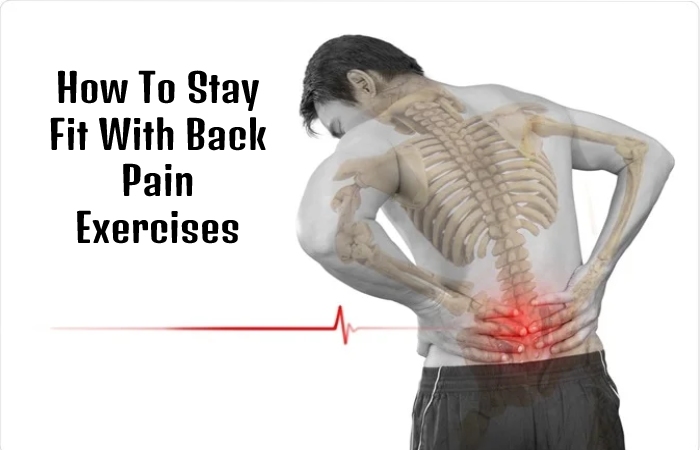Table of Contents
How To Stay Fit With Back Pain?
How to stay fit with back pain: Do you repeatedly suffer from back pain, or are you acutely struggling with a nasty pulling or pinching in your lower back? Then it’s high time to get active, primarily physically. In most cases, restraint is precisely the wrong measure. Even if you feel more comfortable on the couch and it takes a lot of effort to overcome the pain, the proper movement is precisely what you need now.
How to stay fit with back pain, Even if you are one of the 20 percent of people who have never had back pain, you should not only sit back and relax but also come to the fitness mat for prevention so that you remain flexible and pain-free for a long time. We explain what is essential and which exercises help immediately and permanently against back pain. It’s never too late to start!
Where Does Back Pain Come From And How To Stay Fit With Back Pain?
In most cases, back pain is non caused by incorrect movement but rather by a lack of exercise. The human body isn’t designed by nature to sit in a sitting position for most of the day and bang on a keyboard with slumped shoulders for 8 hours or more. Only to transport the stiff limbs comfortably home after work, sitting on the bus, train, or car, and to bed them on a comfortable piece of furniture, where the muscles are also relieved of any compensatory work.
Another disadvantage: Modern people sit far not only too much but also very softly. Initially, this body was intended for hunting and gathering, fleeing from the saber-toothed tiger, and doing heavy physical labor. They rested and slept on furs on the floor instead of luxuriously in premium spring core beds. The human body is quite robust and resilient. But if these stresses are eliminated due to the modern lifestyle, you can quickly get bogged down when carrying a box. However, inactivity is not only a problem for shortened muscles, tendons, and ligaments but also for physical health in general: sitting is the new smoking.
Three-quarters of an hour of exercise after work cannot compensate for the entire day’s inactivity. Sound frustrating? So you can save yourself the jogging tour or the course of the sport right away? No, You don’t have to sweat for two hours in the gym but integrate more small movements into your everyday life. Our muscles need at least one hour, better than 75 minutes of activity spread throughout the day.
There are many types of Exercises Recommended How To Stay Fit With Back Pain
- To go biking
- Daily activities such as cleaning and gardening.
- Low-impact aerobics.
- Resistance exercises.
- Cycling while stationary.
- To swim.
- tai chi
How To Stay Fit With Back Pain Exercises?

1. Back Rehabilitation Exercises:
The multifidus muscle is one of the most important muscles to consider when treating back pain. This small muscle in the back runs from vertebra to vertebra, and its job is to protect your vertebra from slipping forward relative to other moving vertebrae and gravity.
The pelvic lift trains the multifidus muscle to react faster.
Initially, lie on your back and bend your knees. Then cross your arms in front of your chest to reduce offset, which affects the effectiveness of the exercise.
Finally, raise your pelvis toward the ceiling/sky and hold it there for 10 seconds. Repeat this exercise two times a day in sets of 10.
2. Leg Slide
Its core consists of the axial skeleton and the muscles that surround the spine. This is one of the finest exercises to support your lower back and core muscles.
First, you lie on your back. Place your hands on your hip bones and find a neutral spine. Keep your feet firmly planted on the floor while bending your knees.
Tighten your abs and exhale as you straighten your right leg and lift your heel off the floor. Then return to your starting position.
Do 6 to 8 repetitions of this exercise on each leg.
3. Hip Bridge
Don’t like living with back pain? Here’s how to build a bridge and get over it: Do hip bridges. The hip bridge exercise strengthens the posterior muscles of the back, legs, and hips.
This exercise is relatively easy.
First, lie on the flooring with your arms at your sides. Bend your knees while keeping your feet firmly on the floor.
While keeping your shoulder blades straight and on the floor, lift your hips. Hold your pelvis like this for 20 to 30 seconds.
4. Raise Upper Body
Upper body exercises work the large back muscles so you can stay on your feet for long periods.
First, lie on your stomach. Place your arms behindhand your head as you lift your torso. (This includes your components.)
During this exercise, keep your feet on the floor. Repeat this exercise in reps of 10. Try increasing your count to 15 or 20 and do three sets of more practice.
Do this exercise at least twice a day: once in the morning and once in the evening.
5. Come Down
The more afraid you are of bending over, your back pain will get worse. You should arch your back to keep it straight and protected.
First, start by arching your neck and chest. Then you lean further down. Keep your lower back arched as you reach for your toes.
Lift your body without using your hands. This strengthens your core and helps you get used to bending.
It’s okay if you feel slight tightness in your lower back muscles when you bend over.
6. Bird Dog
The Bird Dog will improve your stability and balance and strengthen your core and hip muscles.
Get on all fours. Extend your left leg over you and flex your foot by bending it forward. Then bounce your right arm out in front of you, thumb up.
Tighten your abs while stabilizing your left shoulder, so it doesn’t drop into the pose. Hold this position for 10 to 30 seconds before repeating it on the other side.
7. Walk
Low-impact aerobic exercise can help people with back pain strengthen and condition their muscles. Walking can improve several aspects of your health, including your back.
The walks you take for chores, work, and errands will not be enough, and you must walk 20 to 30 minutes without stopping to reap the cardiovascular benefits.
If you find walking boring, listen to music. As a result, time passes a little faster when walking.
8. Partial Crunches
Strengthen your back and abdominal muscles with incomplete crunches. This exercise is considered incredibly safe for people with back pain.
First, lie down with your knees bent and your feet flat on the floor. You can cross your arms behind your back or in front of your chest. Then, tighten your abs and exhale as you lift your shoulders off the floor.
Hold the position for a second, and then lower yourself. Repeat this exercise 8 to 12 times. Be careful not to drive with your elbows or use arm strength to compensate.
9. Sit Against the Wall
Wall sitting is another safe exercise that people with back pain can easily do.
Start by stand-up 10 to 12 inches from the wall. Lean back until your back is flat and straight against the wall.
Slowly slide down the wall until your knees are bent. Your back should remain pressed against the wall, and your position should appear as if you are sitting on an invisible chair.
Hold this place for 10 seconds, then push the wall up to stand up. Repeat this exercise 8 to 12 times.
10. Back Extension
Research has shown that using this back stretch exercise reduces lower back pain and the degree of disability from back injuries.
Lie on your stomach with your arms at your sides. (Seriously, your arms shouldn’t leave your sides during this exercise.)
Then, use only your lower back muscles to raise your head and shoulders off the floor. Then slowly, more down to the floor. To repeat.
Get Rid of Your Back Pain with Exercise
Almost 30.2% of women and 26.4% of men suffer from back pain. If you do these back rehabilitation exercises, you will be in better shape than ever.
Stop wasting your life and start exercising.
Are you looking for more information? Discover the different medical conditions that cause back pain.
Isn’t a Herniated Disc A Problem For Older People?
Herniated discs can affect anyone over 30 or 40, whether athletic or not. In addition to inactivity, structural changes in the musculoskeletal system can also be responsible for back pain. Signs of wear and tear appear with increasing age, with the intervertebral discs being the most affected. But contrary to many assumptions, a herniated disc does not mean the end of all sportiness. On the contrary, with the right back to school, sufferers learn today that the right amount of exercise helps to live well with the symptoms.
Movement is the be-all and end-all. “Back pain is often a vicious cycle because most people adopt a relieving posture and the cause is not remedied, and in the worst case, further complaints can arise
Conclusion
How to stay fit with back pain, Its a systematic review of the effects of exercise and physical activity on chronic nonspecific low back pain found:
A general exercise program that combines muscle strength, flexibility, and aerobic fitness is beneficial for rehabilitating chronic nonspecific low back pain. Increased core muscle strength can help support the lumbar spine. Improving the flexibility of the back muscles, tendons and ligaments increases the range of motion and supports the patient’s functional movement. Aerobic exercise increases blood flow, and nutrition to the soft tissues of the back improves the healing process and reduces stiffness that can lead to back pain.
And remember, the critical message is that starting regular exercise will benefit a person’s overall health, including reducing back pain. With practice, they will look and feel better.

